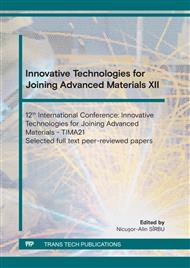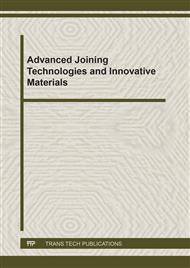[1]
G.V. Mnerie, a.o., FSW-US hybrid process joining of engineering materials, Key Eng. Mat. (volume 890), pp.47-55, (online), https://doi.org/10.4028/www.scientific.net/KEM.890.47, June (2021).
DOI: 10.4028/www.scientific.net/kem.890.47
Google Scholar
[2]
R. Cojocaru, a.o., Contributions to the development of friction stir welding process, The 6th International Conference – Innovative technologies for joining advanced materials, TIMA 2012, Timisoara, Romania, ISSN 1844-4938, (2012).
Google Scholar
[3]
V. Verbițchi, a.o., Experiments for the innovative processes: friction stir soldering (FSS), laser soldering, electric soldering, as well as weld-brazing, Workshop Promoting New Ecological Solders in Romanian-Serbian Cross-Border area,, project ECOSOLDER MIS ETC 1409, Bor, Republic of Serbia, 1st July (2014).
Google Scholar
[4]
ASM Special Handbook: Magnesium and Magnesium Alloys, ASM International, p.106–118, (1999).
Google Scholar
[5]
C. M. Vivek, S. P. Manikandan and J. Kesavan, A review on friction stir welding of titanium alloys, Indian J. Sci. Res. 14 (1): 244-247, (2017).
Google Scholar
[6]
D. Liu, Y. Tang, M. Shen, Y. Hu and L. Zhao, Analysis of weak zones in friction stir welded magnesium alloys from the viewpoint of local texture: a short review, Metals, 8(11), 970 https://doi.org/10.3390/met8110970, (2018).
DOI: 10.3390/met8110970
Google Scholar
[7]
D. Sameer Kumar, a.o., Magnesium and its alloys in automotive applications – a review, American Journal of Materials Science and Technology, vol.4, no.1, pp.12-30, (2015).
Google Scholar
[8]
F. C. Liu, Y. Hovanski, a.o., A review of friction stir welding of steels: Tool, material flow, microstructure and properties, J. Mater. Sci. Technol, vol. 34, Issue 1, pp.39-57, https://doi.org/10.1016/j.jmst.2017.10.024, (2018).
DOI: 10.1016/j.jmst.2017.10.024
Google Scholar
[9]
L. Cederqvist, Friction Stir Welding of Copper Canisters Using Power and Temperature Control. Doctoral Thesis. Lund University, Faculty of Engineering, (2011).
Google Scholar
[10]
S. H Chowdhury, a.o., Friction stir welded AZ31 magnesium alloy: microstructure, texture, and tensile properties; Metall. Mater. Trans A, 44(1), 323-336, (2013).
DOI: 10.1007/s11661-012-1382-3
Google Scholar
[11]
H. Zhang a.o., Effect of heat-input on pitting corrosion behavior of friction stir welded high nitrogen stainless steel, J. Mater. Sci. Technol., online 22 January (2019).
Google Scholar
[12]
K. M. Venkatesh, a.o., Review on friction stir welding of steels, Mater. Today: Proceedings, Volume 5, Issue 5, Part 2, , Pages 13227-13235, (2018).
DOI: 10.1016/j.matpr.2018.02.313
Google Scholar
[13]
K. Gangwar and M. Ramulu, Friction stir welding of titanium alloys: A review, Mater. Des., Volume 141,Pages 230-255, (2018).
DOI: 10.1016/j.matdes.2017.12.033
Google Scholar
[14]
K. Savolainen – Friction stir welding of copper and microstructure and properties of the welds, Aalto University publication series, doctoral dissertations, 13/(2012).
Google Scholar
[15]
K. Singh, G. Singh and H. Singh – Review on friction stir welding of magnesium alloys, J. Magnes. Alloy 6, 399-416, (2018).
DOI: 10.1016/j.jma.2018.06.001
Google Scholar
[16]
K. Chiteka - Friction Stir Welding of steels: A Review Paper, IOSR-JMCE, e-ISSN: 2278-1684, p-ISSN: 2320-334X, Volume 9, Issue 3, pp.16-20, (2013).
DOI: 10.9790/1684-0931620
Google Scholar
[17]
M. Mahmoudiniya, a.o., Microstructure and mechanical properties of friction stir welded ferrite-martensite DP700steel, Mater. Sci. Eng. A,Vol.737, Pp.213-222, (2018).
DOI: 10.1016/j.msea.2018.09.013
Google Scholar
[18]
T. R. McNelley, a.o., Microstructures and Properties of Copper Alloys after Friction Stir Welding/Processing. In: Mishra, R.S. and Mahoney, M.W. (eds.) Friction Stir Welding and Processing. Ohio, USA, ASM International, pp.155-174, ISBN 0-87170-840-X, (2007).
DOI: 10.1002/9781118062302.ch8
Google Scholar
[19]
M. Damircheli and A. Shirazi, Microstructurals and mechanical properties of FSWed cooper plates under usage of shielding gas for different welding parameters, Mater. Res. Express, Volume 6, Number 6, (2019).
DOI: 10.1088/2053-1591/ab08e4
Google Scholar
[20]
M.A.M. Duke, Friction stir welding of steel, Int. J. Eng. Technol., Vol: 03 Issue: 09|Sep-2014, http://www.ijret.org 286, (2014).
Google Scholar
[21]
R. Rai, A. De, H. K. D. H. Bhadeshia and T. DebRoy, Review: friction stir welding tools, Sci. Technol. Weld. Join., Vol.16, No 4. 325, (2011).
DOI: 10.1179/1362171811y.0000000023
Google Scholar
[22]
R. Sarrafi, a.o., Evaluation of Microstructure and Mechanical Properties of Aluminium to Copper Friction Stir Butt Welds. In: Mishra, R., Mahoney, M.W., Sato, Y., Hovanski, Y., and Verma, R. (eds.) Friction Stir Welding and Processing VI. Pennsylvania, USA: The Minerals, Metals & Materials Society. Pp. 253-264. ISBN 978-1-11800-201-8, (2011).
DOI: 10.1002/9781118062302.ch31
Google Scholar
[23]
S. Mironov, Y. S .Sato and H. Kokawa - Friction-stir welding and processing of Ti-6Al-4V titanium alloy: A review, - J. Mater. Sci. Technol., 34(1): 58-72, (2018).
DOI: 10.1016/j.jmst.2017.10.018
Google Scholar
[24]
B. Thompson, a.o., Tool degradation characterization in the friction stir welding of hard metals, Weld. J. (Miami, Fla), 89 (12): 256s-261s, (2010).
Google Scholar
[25]
T. Watanabe, a.o., Joining of Aluminium Alloy to Steel by Friction Stir Welding. J. Mater. Process. Technol. 178. Pp. 342- 349, (2006).
Google Scholar
[26]
Z. Iqbal, A. Bazoune, F. Al-Badour and A.N. Shuiab, Effect of Tool Rotational Speed on Friction Stir Welding of ASTM A516-70 Steel Using W–25%Re Alloy Tool, Arab. J. Sci. Eng., July 2018, https://doi.org/10.1007/s13369-018-3452-3, (2018).
DOI: 10.1007/s13369-018-3452-3
Google Scholar
[27]
information on http://www.cfswt.com/cfswc/en/te/tech-metarial-cu.html.
Google Scholar
[28]
information on http://www.automobile-steel.com/Automotive-steel/EN-10111-DD13.html.
Google Scholar
[29]
S. Moga, Analysis report XRD stress for DD13 steel welded samples, R&D Regional Center for Innovative Materials, Processes and products Designed for the Automotive Industry, University of Pitesti, 03.06.(2021).
Google Scholar
[30]
L. N. Boțilă, R. Cojocaru, a.o., Research on the development of new innovative methods of application of the friction stir welding process in order to expand the possibilities of application in priority areas, project PN 19.36.01.01, funded by the Ministry of Research, innovation and Digitization (Nucleu Program of ISIM Timisoara, contract 35N/2019-2022).
DOI: 10.4028/p-wr0f72
Google Scholar
[31]
B. L. Mordike and T. Ebert, Magnesium: properties-applications-potential, Mater. Sci. Eng. A, Vol. 302, p.37–45, (2001).
Google Scholar
[32]
L. Commin, a.o., Friction stir welding of AZ31 magnesium alloy rolled sheets: Influence of processing parameters, Acta Mater; 57:326–34 (2009).
DOI: 10.1016/j.actamat.2008.09.011
Google Scholar



